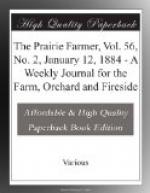AMERICAN ASH.
There are five well-known species of this genus (Fraxinus Americana), and they occupy an important place as valuable timber trees. This is especially true of the white ash, more commonly called the American ash. Of this tree the late Arthur Bryant, Sr., said in his Book on Trees: “It is one of the most valuable and worthy of culture for the quality of its wood and the rapidity of its growth. When full grown it is one of the largest of the trees of our forests. * * * * The prairie soils of Iowa and Central and Northern Illinois are well adapted to the growth of the white ash.”
WAYSIDE NOTES.
BY A MAN OF THE PRAIRIE.
It is a strange and almost an unheard of thing for any one to say a good word for the “tree peddler” but I am going to say it if it breaks the heart of every horticultural baby in the land. Since a time to which the memory of man runneth not back, the poor “tree peddler” has been abused and maligned by horticultural speakers and writers. In conventions he has been ridiculed and denounced. Every cross-road nursery-man not possessed of stock sufficient to warrant a line of advertising even in his local paper, nor business force enough to send an agent through his own neighborhood to take orders for trees, has spoken in a horticultural meeting or written a letter to his favorite paper, warning the farmers against the wiles of the oily tongued fellow with colored fruit plates, specimens of preserved fruits, and an order book for trees, shrubs, and vines. And I think I have known of some of the big fish in the nursery business who with one end of their tongues have lashed some other big fish in the same business for employing irresponsible agents to sell stock for them, while with the other end they were commanding a small army of the same class of agents to go forth into all the world and preach the gospel of tree planting and—sell trees. Others have sold and continue to sell trees to peddlers without limit, for cash, and of any and all varieties called for, while




